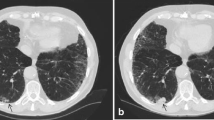Abstract
Objectives
To prospectively evaluate the impact of iterative reconstruction (IR) algorithms on pulmonary emphysema assessment as compared to filtered back projection (FBP).
Methods
One hundred ten unenhanced chest CT examinations were obtained on two different scanners. Image reconstructions from a single acquisition were done with different levels of IR and compared with FBP on the basis of the emphysema index (EI), lung volume and voxel densities. Objective emphysema assessment was performed with 3D software provided by each manufacturer. Subjective assessment of emphysema was performed as a blinded evaluation. Quantitative and subjective values were compared using repeated ANOVA analysis, Bland-Altman analysis and Kendall’s coefficient of concordance (W).
Results
Lung volumes are stable on both units, throughout all IR levels (P ≥ 0.057). EI significantly decreases on both units with the use of any level of IR (P < 0.001). The highest levels of IR are responsible for a decrease of 33-36 % of EI. Significant differences in minimal lung density are found between the different algorithms (P < 0.003). Intra- and inter-reader concordance for emphysema characterisation is generally good (W ≥ 0.77 and W ≥ 0.86, respectively).
Conclusions
Both commercially available IR algorithms used in this study significantly changed EI but did not alter visual assessment compared to standard FBP reconstruction at identical radiation exposure.
Key points
• Objective quantification of pulmonary emphysema is sensitive to iterative reconstructions
• Subjective evaluation of pulmonary emphysema is not influenced by iterative reconstructions
• Consistency in reconstruction algorithms is of paramount importance for pulmonary emphysema monitoring





Similar content being viewed by others
Abbreviations
- ASiR:
-
Adaptive statistical image reconstruction
- EI:
-
Emphysema index
- FBP:
-
Filtered back projection
- IR:
-
Iterative reconstruction
- LAV%:
-
Low attenuation value percentage
- SAFIRE:
-
Sinogram affirmed iterative reconstruction
- MBIR:
-
Model-based iterative reconstruction
References
Gevenois PA, de Maertelaer V, De Vuyst P, Zanen J, Yernault JC (1995) Comparison of computed density and macroscopic morphometry in pulmonary emphysema. Am J Respir Crit Care Med 152:653–657
Gevenois PA, De Vuyst P, de Maertelaer V et al (1996) Comparison of computed density and microscopic morphometry in pulmonary emphysema. Am J Respir Crit Care Med 154:187–192
Madani A, Zanen J, de Maertelaer V, Gevenois PA (2006) Pulmonary emphysema: objective quantification at multi-detector row CT − comparison with macroscopic and microscopic morphometry. Radiology 238:1036–1043
Muller NL, Staples CA, Miller RR, Abboud RT (1988) Density mask. An objective method to quantitate emphysema using computed tomography. Chest 94:782–787
Dawkins PA, Dowson LJ, Guest PJ, Stockley RA (2003) Predictors of mortality in alpha1-antitrypsin deficiency. Thorax 58:1020–1026
Stockley RA, Parr DG, Piitulainen E, Stolk J, Stoel BC, Dirksen A (2010) Therapeutic efficacy of alpha-1 antitrypsin augmentation therapy on the loss of lung tissue: an integrated analysis of 2 randomised clinical trials using computed tomography densitometry. Respir Res 11:136
Parr DG, Stoel BC, Stolk J, Stockley RA (2006) Validation of computed tomographic lung densitometry for monitoring emphysema in alpha1-antitrypsin deficiency. Thorax 61:485–490
Botsikas D, Stefanelli S, Boudabbous S, Toso S, Becker CD, Montet X (2014) Model-based iterative reconstruction versus adaptive statistical iterative reconstruction in low-dose abdominal CT for urolithiasis. AJR Am J Roentgenol 203:336–340
Nishio M, Matsumoto S, Seki S et al (2014) Emphysema quantification on low-dose CT using percentage of low-attenuation volume and size distribution of low-attenuation lung regions: effects of adaptive iterative dose reduction using 3D processing. Eur J Radiol 83:2268–2276
Mets OM, Willemink MJ, de Kort FP et al (2012) The effect of iterative reconstruction on computed tomography assessment of emphysema, air trapping and airway dimensions. Eur Radiol 22:2103–2109
Choo JY, Goo JM, Lee CH, Park CM, Park SJ, Shim MS (2014) Quantitative analysis of emphysema and airway measurements according to iterative reconstruction algorithms: comparison of filtered back projection, adaptive statistical iterative reconstruction and model-based iterative reconstruction. Eur Radiol 24:799–806
Lynch DA, Austin JH, Hogg JC et al (2015) CT-definable subtypes of chronic obstructive pulmonary disease: a statement of the Fleischner Society. Radiology. doi:10.1148/radiol.2015141579:141579
Geyer LL, Schoepf UJ, Meinel FG et al (2015) State of the art: iterative CT reconstruction techniques. Radiology 276:339–357
Neroladaki A, Botsikas D, Boudabbous S, Becker CD, Montet X (2013) Computed tomography of the chest with model-based iterative reconstruction using a radiation exposure similar to chest X-ray examination: preliminary observations. Eur Radiol 23:360–366
Montet X, Hachulla AL, Neroladaki A et al (2015) Image quality of low mA CT pulmonary angiography reconstructed with model based iterative reconstruction versus standard CT pulmonary angiography reconstructed with filtered back projection: an equivalency trial. Eur Radiol 25:1665–1671
Mieville FA, Gudinchet F, Brunelle F, Bochud FO, Verdun FR (2013) Iterative reconstruction methods in two different MDCT scanners: physical metrics and 4-alternative forced-choice detectability experiments − a phantom approach. Phys Med 29:99–110
Acknowledgments
The scientific guarantor of this publication is PR Xavier Montet. The authors of this manuscript declare no relationships with any companies, whose products or services may be related to the subject matter of the article. The authors state that this work has not received any funding.
No complex statistical methods were necessary for this paper. Institutional Review Board approval was obtained. Written informed consent was obtained from all subjects (patients) in this study. Methodology: prospective, case-control study, performed at one institution.
Author information
Authors and Affiliations
Corresponding author
Rights and permissions
About this article
Cite this article
Martin, S.P., Gariani, J., Hachulla, AL. et al. Impact of iterative reconstructions on objective and subjective emphysema assessment with computed tomography: a prospective study. Eur Radiol 27, 2950–2956 (2017). https://doi.org/10.1007/s00330-016-4641-7
Received:
Revised:
Accepted:
Published:
Issue Date:
DOI: https://doi.org/10.1007/s00330-016-4641-7




